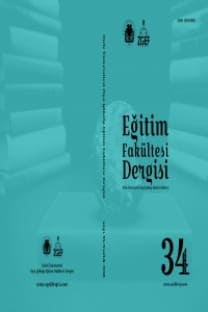HÜCRE BÖLÜNMELERİNİN ÖĞRETİMİNDE YENİ BİR YAKLAŞIM: “BÖLÜNEN PARMAKLAR”
Yapılan çalışmanın amacı hücre bölünmelerinin öğretiminde yeni bir öğretim etkinliği (bölünen parmaklar) geliştirmek, bu öğretim etkinliğini öğrenciler üzerinde uygulamak ve geleneksel öğretim etkinlikleriyle kıyaslayarak geliştirilen etkinliğin etkililik derecesini belirlemektir. Çalışma 2006-2007 öğretim yılında, Atatürk Anadolu Lisesi’nde okuyan toplam 58 lise 1 öğrencisiyle yapılmıştır. Çalışmada ön test-son test kontrol gruplu desen kullanılmıştır. Öğrencilerden 30’u geleneksel yöntemlerle öğretim yapılan kontrol grubunda yer alırken diğer 28 birey “bölünen parmaklar” adlı öğretim etkinliğinin uygulandığı deney grubunda yer almıştır. Çalışmada veri toplama aracı olarak “Hücre Bölünmeleri Erişi Belirleme Testi (HBEBT)” kullanılmıştır. Bölünen parmaklar öğretim etkinliği Gagne’nin öğretim etkinlikleri modeli temel alınarak hazırlanmıştır. Etkinlikte bölünme safhaları ve bu safhalardaki kromozom davranışları parmaklar ile sembolize edilmiştir. Analiz sonuçlarına göre hem kontrol hem de deney grubunda öğretim süreci sonunda öğrenci erişilerinin anlamlı şekilde arttığı ancak her iki grubun son testleri kıyaslandığında deney grubunun lehine anlamlı bir farklığın bulunduğu tespit edilmiştir. Bu sonuç bölünen parmaklar adlı öğretim etkinliğinin hücre bölünmeleri ünitesinde geleneksel yöntemlere nazaran daha başarılı olduğunu göstermiştir.
Anahtar Kelimeler:
Hücre bölünmeleri, öğretim etkinliği, biyoloji eğitimi
A New Approach In Teaching Of Cell Divisions: “Divided Fingers”
The purpose of this study is to develop a new teaching activity in teaching of cell divisions, to implement this activity to students’ level of effectiveness of this activity by compairing with traditional methods. This study was carried out with 58 from 1st grade of the highschool in Atatürk Anatolian Highschool in 2006-2007 academic year. Pre test - post test controlled group design was used in the study. While there were 30 pupils in control group who were taught by traditional methods, there are 28 pupils in experimental group who were taught by teaching activity named as “Divided fingers”. “Cell Division Achievement Test (CDAT)” was used as data collecting material in the study. The activity called “Divided fingers” is based on “teaching activities model” which was developed by Gagne. In the activity, division phases and choromosomes’ behaviours in this phases have been symbolized with fingers. According to the results pupils’ achievements have raised meaningfully both in control and in experimental groups, but when groups’ post tests have been compaired, there is a meaningful difference in favour of experimental group
Keywords:
Cell divisions, teaching activite, biology education,
___
- Alparslan, C., Tekkaya, C. ve Geban, Ö. (2003). Using The Conceptual Change Instruction To İmprove Learning. Journal Of Biology Education. 37(3). 133-137.
- Amir, R. ve Tamir, P. (1994) In-Depth Analysis Of Misconceptions As A Basis For Developing Research-Based Remedial İnstruction: The Case Of Photosynthesis. The American Biology Teacher. 56. 94-100
- Atılboz, N. G.(2001). Lise 1. Sınıf Öğrencilerinde Hücre Ve Moleküler Biyoloji Konuları İle İlgili Görsel ve Deneysel Malzeme Kullanımının Başarı Üzerine Etkisi. Yayınlanmamış Yüksek Lisans Tezi. Gazi Üniversitesi.
- Atılboz, N.G. (2004). Lise 1. Sınıf Öğrencilerinin Mitoz ve Mayoz Bölünme Konuları İle İlgili Anlama Düzeyleri ve Kavram Yanılgıları. Gazi Eğitim Fakültesi Dergisi. 24(3). 147-157.
- Bahar, M., Jhonstone, A. H. ve Hansell, M. H. (1999). Revisiting Learning Difficulties İn Biology. Journal Of Biology Education. 33(2). 84-86.
- Brown, C. R. (1990). Some Misconceptions İn Meiosis Shown By Students Responding To An Advanced - Level Practical Examination Question Biology. Journal Of Biological Education. 24(3). 182-186.
- Cho, H. H., Kahle, J. B. ve Nordland F. H. (1985). An İnvestigation Of High School Biology Textbooks As Sources Of Genetics And Some Suggestions For Teaching Genetics. Science Education. 69. 707-719
- Gagne, R. M. (1985). The conditions of learning and theory of Instruction (Dördüncü baskı). New York: Holt, Rinehart ve Winston.
- Kindfield, A. C. H. (1994). Understanding A Basic Biological Process. Expert And Novice Models Of Meiosis. Science Education. 78. 255-283.
- Lewis, J., Leach, J. ve Wood- Robinson, C. (2000). Choromosomes: The Missing LinkYounge Peoples’s Understanding Of Mitosis, Meiosis And Fertilisation. Journal Of Biological Education. 34(4). 189-191.
- Lewis, J. ve Wood- Robinson, C. (2000). Genes, Choromosomes, Cell Division And İnheritance -Do Students See Any Relationship?. İnternational Journal Of Science Education, 22. 177-197.
- Mann, M. ve Treagust, D. F. (1998). A Pencil And Paper Instrument To Diagnose Students’ Conceptions Of Breathing, Gas Exchange And Respiration. Australian Science Teachers Journal. 44. 55-60
- Nuffield Foundation (1998). Beyond 2000: Science Education For Future. Nuffield Foundation. London.
- Odom, A. L. (1995). Secondary And College Biology Students’ Misconceptions About Diffusion And Osmosis. The American Biology Teacher. 57. 409-415.
- Öztap, H., Özay, E. ve Öztap, F. (2003). Teaching Cell Division To Secondary School Students: An İnvestigation Of Difficulties Experienced By Turkish Teachers. Journal Of Biology Education. 38(1).13-15.
- Pashley, M. (1994). A-Level Students: Their Problems With Gene And Allele. Journal Of Biological Education. 28(2). 120-126.
- Senemoğlu, N. (2002). Kuramdan uygulamaya Gelişim öğrenme ve öğretim. Gazi kitabevi. Ankara
- Smith, M. U. (1991). Teaching Cell Division: Student Difficulties And Teaching Recommendations. Journal Of College Scinece Teaching. Sept / Oct. (21). 145-150.
- Tekkaya, C., Özkan, Ö. ve Sungur, S. (2001). Lise Öğrencilerinin Zor Olarak Algıladıkları Biyoloji Kavramları. H.Ü. Eğitim Fakültesi Dergisi. 21. 145-150.
- Yip, D. Y. (1998). Identification Of Misconceptions İn Naive Biology Teachers And Remedial Strategies For İmproving Biology Learning. İnternational Journal Of Science Education. 20. 461-477.
- ISSN: 1305-0060
- Yayın Aralığı: Yılda 2 Sayı
- Başlangıç: 1995
- Yayıncı: Dicle Üniversitesi
Sayıdaki Diğer Makaleler
FEN EĞİTİMİNDE PROBLEM ÇÖZME İLE İLGİLİ AÇIKLAMALI KAYNAKÇA
DEDE KORKUT HİKÂYELERİNDE SÖZ KALIPLARI
NUSAYBİN’İN FİZİKİ COĞRAFYA ÖZELLİKLERİ
OKUL ANNELİĞİ: OKUL GÜVENLİĞİNE YÖNELİK BİR MODEL ÖNERİSİ
BİLİŞSEL ÖĞRENMELER İÇİN ELEŞTİREL OKUMANIN ÖNEMİ ve ONU GELİŞTİRME YOLLARI
SERUM NMR T1 DURULMASI İÇİN ÖNERİLEN TABAKA MODELİNDEN KİMYASAL DEĞİŞ-OLUŞ FORMÜLLERİNİN TÜRETİMİ
